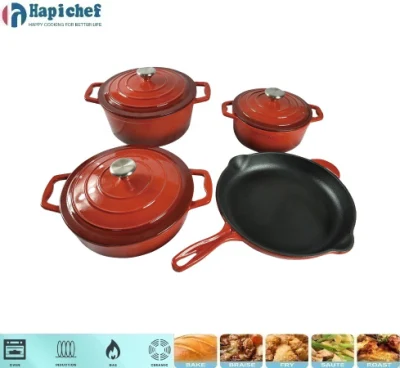cast iron fajita pan factory
The Journey of Cast Iron Fajita Pan Production A Look into Factory Operations
Cast iron fajita pans have gained popularity in kitchens around the world, celebrated for their ability to retain heat and enhance the flavor of meals. The factory process behind these beloved cooking tools is a fascinating journey, showcasing craftsmanship, technology, and attention to detail.
Understanding Cast Iron Fajita Pans
Cast iron cookware has been cherished for centuries, known for its durability and excellent heat retention. Fajita pans, specifically designed for serving sizzling fajitas, often come with handles and are able to transition from stovetop to oven seamlessly. The allure of a well-cooked fajita, that sizzles and steams upon being served, is partly due to the properties of cast iron that allow the pan to maintain high temperatures.
The Production Process
The production of cast iron fajita pans begins with raw materials. High-quality iron ore is sourced, and then subjected to a melting process in a furnace. This metallurgical phase is critical, as the molten iron must reach a specific temperature to ensure that it can be poured into molds without any impurities. The factory typically employs advanced technology to monitor the temperature and composition of the molten iron, ensuring consistency and quality.
Once the iron is melted, it is poured into molds that are specially designed for fajita pans. These molds are often made from sand, which allows for a fine finish on the surface of the pan. After the molten iron cools and solidifies, the pans are removed from the molds for further processing.
cast iron fajita pan factory

Finishing Touches and Quality Control
The next step is finishing. Each pan is meticulously polished to remove any rough edges. This process not only enhances the aesthetic appearance but also ensures safety during use. Following polishing, the pans are seasoned. This involves applying a layer of vegetable oil and heating the pan, which creates a non-stick surface that enhances flavor and prevents rusting. The seasoning process is vital, as it affects the longevity and usability of the pan.
Quality control is a significant aspect of the production process. Each fajita pan undergoes rigorous testing to ensure it meets safety standards and performance expectations. Factories often have a dedicated team that inspects each pan for defects, ensuring that consumers receive only the best products.
Sustainability Practices
In today’s world, sustainability is more important than ever. Many factories producing cast iron fajita pans are adopting eco-friendly practices. They utilize recycled materials in their production and implement energy-efficient processes to minimize their carbon footprint. Additionally, cast iron cookware is known for its longevity, allowing consumers to reduce waste by investing in durable products rather than disposable alternatives.
Conclusion
The factory process behind cast iron fajita pans is a testament to combining traditional craftsmanship with modern technology. From sourcing raw materials to the final product reaching consumers, each step is crucial in creating a high-quality cooking tool that continues to bring joy to kitchens everywhere. As consumers become more conscious about the tools they use, cast iron cookware, particularly fajita pans, stands out as a perfect blend of functionality, sustainability, and culinary tradition. The sizzling sound of fajitas being served is a reminder of the craftsmanship and care that goes into every pan.
-
Why Every Kitchen Needs a Casserole Cast Iron DishNewsJun.24,2025
-
Experience the Tradition and Quality of Cast Iron CookwareNewsJun.24,2025
-
Double Sided Cast Iron Grill PanNewsJun.24,2025
-
Cast Iron Dutch Ovens You’ll Actually UseNewsJun.24,2025
-
Buy Cast Iron Griddle for Everyday CookingNewsJun.24,2025
-
Barbecue Iron Grill Cooking PowerNewsJun.24,2025
-
Standard Product Lines from Cast Iron Cookware SuppliersNewsJun.11,2025
